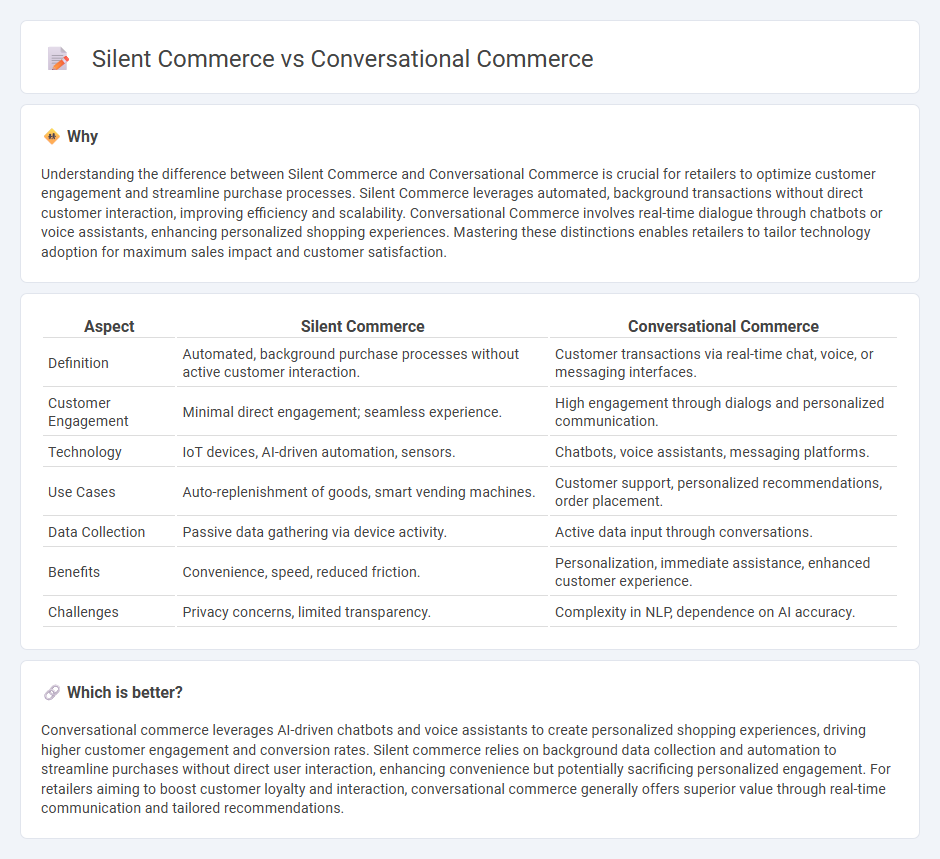
Silent commerce leverages automated systems and AI-driven technologies to enable frictionless transactions without direct customer interaction, focusing on seamless background processes like inventory management and predictive ordering. Conversational commerce, on the other hand, utilizes chatbots and voice assistants to engage customers through natural language dialogue, enhancing user experience by facilitating personalized recommendations and instant purchasing decisions. Explore further to understand how these innovative retail strategies transform customer engagement and operational efficiency.
Why it is important
Understanding the difference between Silent Commerce and Conversational Commerce is crucial for retailers to optimize customer engagement and streamline purchase processes. Silent Commerce leverages automated, background transactions without direct customer interaction, improving efficiency and scalability. Conversational Commerce involves real-time dialogue through chatbots or voice assistants, enhancing personalized shopping experiences. Mastering these distinctions enables retailers to tailor technology adoption for maximum sales impact and customer satisfaction.
Comparison Table
| Aspect | Silent Commerce | Conversational Commerce |
|---|---|---|
| Definition | Automated, background purchase processes without active customer interaction. | Customer transactions via real-time chat, voice, or messaging interfaces. |
| Customer Engagement | Minimal direct engagement; seamless experience. | High engagement through dialogs and personalized communication. |
| Technology | IoT devices, AI-driven automation, sensors. | Chatbots, voice assistants, messaging platforms. |
| Use Cases | Auto-replenishment of goods, smart vending machines. | Customer support, personalized recommendations, order placement. |
| Data Collection | Passive data gathering via device activity. | Active data input through conversations. |
| Benefits | Convenience, speed, reduced friction. | Personalization, immediate assistance, enhanced customer experience. |
| Challenges | Privacy concerns, limited transparency. | Complexity in NLP, dependence on AI accuracy. |
Which is better?
Conversational commerce leverages AI-driven chatbots and voice assistants to create personalized shopping experiences, driving higher customer engagement and conversion rates. Silent commerce relies on background data collection and automation to streamline purchases without direct user interaction, enhancing convenience but potentially sacrificing personalized engagement. For retailers aiming to boost customer loyalty and interaction, conversational commerce generally offers superior value through real-time communication and tailored recommendations.
Connection
Silent commerce and conversational commerce are interconnected through their shared goal of enhancing seamless customer interactions and transactions in retail. Silent commerce utilizes automated technologies like AI and IoT to enable frictionless, background purchasing experiences, while conversational commerce leverages chatbots and voice assistants to facilitate real-time, interactive shopping dialogues. Together, these innovations create a cohesive retail environment that combines discreet automation with personalized communication, driving increased consumer engagement and sales efficiency.
Key Terms
**Conversational commerce:**
Conversational commerce leverages AI-driven chatbots and messaging platforms to facilitate personalized shopping experiences by enabling real-time customer interactions and instant support. This approach enhances customer engagement, boosts conversion rates, and streamlines the purchasing process through natural language interfaces. Discover how conversational commerce transforms retail by driving seamless communication between brands and consumers.
Chatbots
Conversational commerce leverages chatbots to enable real-time, interactive customer engagement, facilitating personalized shopping experiences and instant support through AI-driven conversations. Silent commerce relies on background AI processes and automated systems that complete transactions without direct user interaction, emphasizing seamless and invisible purchasing flows. Explore how chatbot technology transforms customer interactions and enhances sales efficiency in modern commerce.
Messaging platforms
Conversational commerce leverages messaging platforms like WhatsApp and Facebook Messenger to enable real-time interaction between customers and brands, facilitating personalized shopping experiences and instant support. Silent commerce utilizes these platforms to automate purchases through AI-driven chatbots and voice assistants without direct human interaction, streamlining the buying process. Explore how these contrasting approaches redefine customer engagement and sales strategies on popular messaging platforms.
Source and External Links
What is Conversational Commerce? | CM.com Glossary - Conversational commerce enables consumers to shop and communicate with brands seamlessly through messaging channels, voice, and chat, integrating shopping directly within popular messaging apps like WhatsApp and Facebook Messenger.
What Is Conversational Commerce? Definition and Guide - Shopify - Conversational commerce uses chatbots, messaging apps, and voice assistants to facilitate personalized product recommendations, customer support, and streamlined purchases all within natural conversational interfaces in messaging platforms.
What is conversational commerce? Examples, types, + benefits - Conversational commerce improves the shopping experience through real-time chats, click-to-message ads, and interactions via third-party messaging apps, providing personalized assistance and seamless transactions along the customer journey.
 dowidth.com
dowidth.com